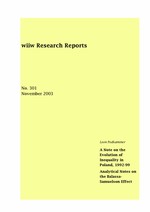A Note on the Evolution of Inequality in Poland, 1992-99 Analytical Notes on the Balassa-Samuelson Effect
A Note on the Evolution of Inequality in Poland, 1992-99
(reprinted from Cambridge Journal of Economics, Vol. 27, No. 5, 2003, pp. 755-768, by permission of Cambridge Political Economy Society)
Income inequality in Poland, after falling over the period 1993-96, rose significantly from 1997 onwards, as indicated by analyses of household budget surveys, national accounts data on functional income distribution and data on the dispersion of wages. Farmers and the unemployed were the main losers. While the overall position of wage-earners improved, wage inequality increased sharply in the second half of the 1990s. Employers and the self-employed fared quite well. This coincided with fiscal policy changes which substantially slowed down progression in income taxes. Over the period 1993-96, growth was high and balanced. Subsequently, growth slowed down, giving rise to serious fiscal and external deficits.
Analytical Notes on the Balassa-Samuelson Effect
(reprinted from Banca Nazionale del Lavoro Quarterly Review, No. 226, 2003, pp. 207-221, by permission of Banca Nazionale del Lavoro)
On closer examination, it transpires that the intuition underlying the Balassa-Samuelson Effect (BSE) is wrong: even in idealized models with highly restrictive features, the BSE need not obtain at all. A proper analysis of conventional models customarily believed to yield the BSE rigorously, in the form of an equation, indicates that changes in the relative prices of non-tradable goods may be totally unrelated to changes in relative productivity levels. In more realistic models (i.e. those tat do not postulate constant returns to scale or allow for intermediate inputs) there is even less room for determinate results supporting the BSE.
Keywords: inequality, fiscal and monetary policy
JEL classification: D63
Countries covered: Poland, Visegrad countries
Research Areas: Macroeconomic Analysis and Policy
